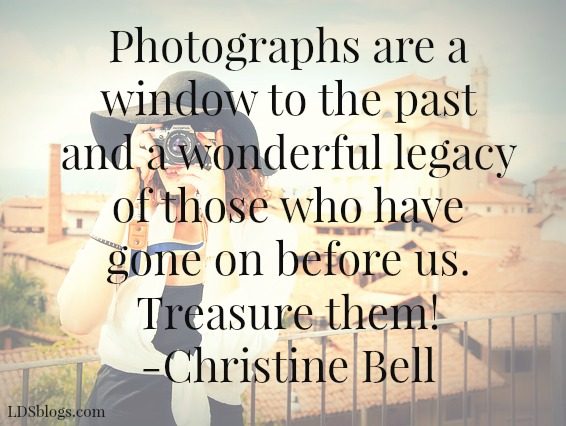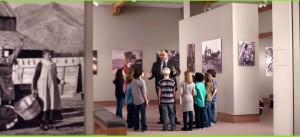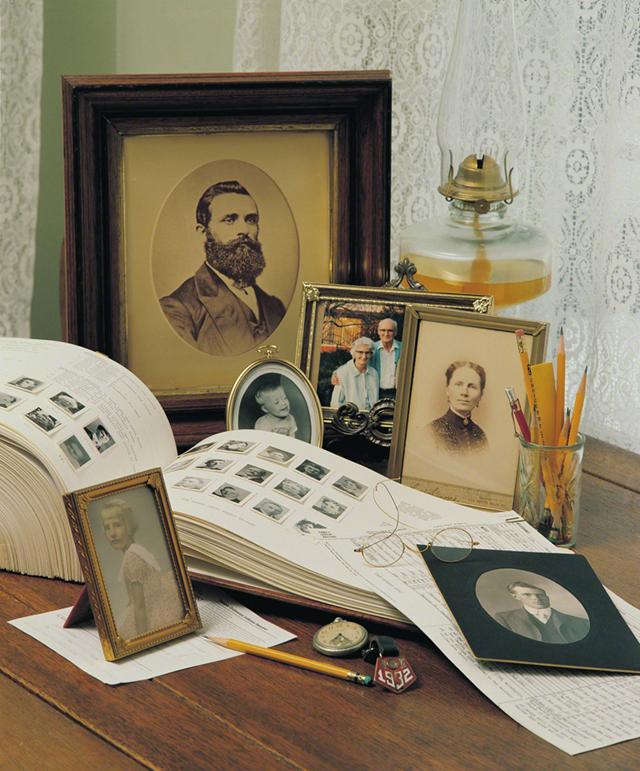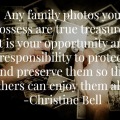Most people hope to live forever in one form or another. One of the ways we can “live forever” is in other people’s memories and in turn, others can live forever in our memoires. Pictures are a very tangible way to capture and preserve memories. A video from FamilySearch.org makes this point in a thought-provoking way. In the video entitled “Preserve Your Photos and Family Memories,” a grandfatherly tour guide escorts a group of children through a very large photography gallery. The children are amazed by the number of photographs displayed. They also observe the reactions that other are having to the photos like the elderly, teary-eyed man gazing at the photo of his late wife as a young woman. The children’s amazement grows as their guide tells them that if they listen carefully, they will hear the pictures talking! What are the pictures saying, they ask him. He responds that the pictures are saying, “keep me, protect me, share me and I will live forever!” This large photo gallery in the video represents the Memories section of Family Tree on FamilySearch.org.
Keep me, protect me, share me and I will live forever! These are stirring words! Let’s start with Keep Me.
Hopefully, you have photographs that you desire to keep. Perhaps these are photographs that have been handed down to you along with pictures you have taken yourself. Pictures taken prior to 1900 take a variety of forms and are often quite different from the photographs taken after 1900. Perhaps you have photographs of stoic, unsmiling ancestors. Lest you think your ancestors were all very solemn people, keep in mind that in the early days of photography, you had to maintain a pose for several minutes! That’s a long time to smile for the camera. Then in 1900 the Kodak camera company revolutionized picture taking by introducing the Brownie camera. The first Brownie cameras were cardboard box cameras with a simple lens and sold for a dollar. They were advertised with the slogan, “You push the button, we do the rest,” and were sold with the idea that almost anyone could both afford and operate one. This allowed people to take candid pictures anywhere. Of course, camera technology continued to improve and in 1963, Kodak introduced the Instamatic which made picture-taking even easier. The film for the Instamatic camera was in a cartridge which made it very easy to load a new roll of film in the camera. As it became so much easier to take pictures, people took more pictures which may explain why you, like me, inherited so many pictures from this time period. And if you are of the digital camera generation, allow me to explain why you may have so many pictures that are very similar and all taken at the same event from this time period. Unlike today, when a picture can be viewed and evaluated as soon as it is taken, pictures taken with film had to be developed before they could be viewed. As a result, people tended to take a lot of pictures of an event to make sure they got at least a few really good ones because by the time the film was developed, the event was over. All pictures taken, even the not so good ones, were often kept because it seemed wasteful to throw them away due to cost of the film and the film developing.
You need to create a method of organizing the pictures you have to help insure someone will keep them. Photos can be organized by who is in the photo, when the photo was taken, where the photo was taken or any other method that makes sense to you. You will also want to scan the paper copy of all photos and organize them in whatever way you choose to organize the paper copies. Once you organize your photos, you will know how many you have of each category and how many are duplicates or near duplicates. Having your photos organized will allow evaluating which photos are truly worth keeping. My next suggestion may seem inconsistent with the admonition to “Keep Me.” The suggestion is: not every picture ever taken is worth keeping. Trying to keep every picture ever taken could create a collection so large and overwhelming that someone, even you in bad mood, may one day dispose of all of them!
If you are the one who inherited many of your family pictures, you will want to reach out to other members of your family and offer to share the duplicates you have. Get together with other family members either in person or through digital means and share the images that you think might be best disposed of because others might see a value in them that you don’t. Even if you are not considering tossing a picture, it would be good to share the photos because others may know stories that go along with the pictures. I found these photos in my grandmother’s photo album and knew there had to be a story to go along with them.
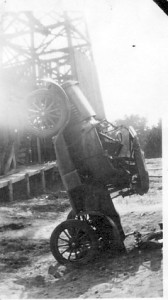
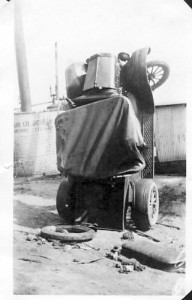 I reached out to an uncle and he told me this story. It seems this old car was parked on a hill. The brake failed and the car started to roll backwards. It stopped when it caught on the support wire of an oil derrick and flipped up on end! More recently, my husband came across a photo taken in front of one of our former residences and neither of us was sure who the children in the picture were. My husband sent a scan of the photo to our older children to see if they had a clue as to who was in the picture. A daughter responded with who was in the picture and a story that went along with the picture. This experience taught me to ask anyone who might know something about a picture and that they might be someone younger than me.
I reached out to an uncle and he told me this story. It seems this old car was parked on a hill. The brake failed and the car started to roll backwards. It stopped when it caught on the support wire of an oil derrick and flipped up on end! More recently, my husband came across a photo taken in front of one of our former residences and neither of us was sure who the children in the picture were. My husband sent a scan of the photo to our older children to see if they had a clue as to who was in the picture. A daughter responded with who was in the picture and a story that went along with the picture. This experience taught me to ask anyone who might know something about a picture and that they might be someone younger than me.
Photographs are a window to the past and a wonderful legacy of those who have gone on before us. Treasure them! Next post I will write about “Protect Them.”
About Christine Bell
Christine Bell has been seeking her ancestor for almost forty years and continues to find joy in each one she finds. She volunteers in a Family Search Family History Center where she helps others find their ancestors. As a convert to The Church of Jesus Christ of Latter-Saints, she is grateful to be a member of the Church. She is a wife, mother of six grown children, grandmother of five going on six, and currently living in the western United States. Christine enjoys spending time with family and creating quilts for family, friends and Humanitarian Services of The Church of Jesus Christ of Latter-day Saints.

